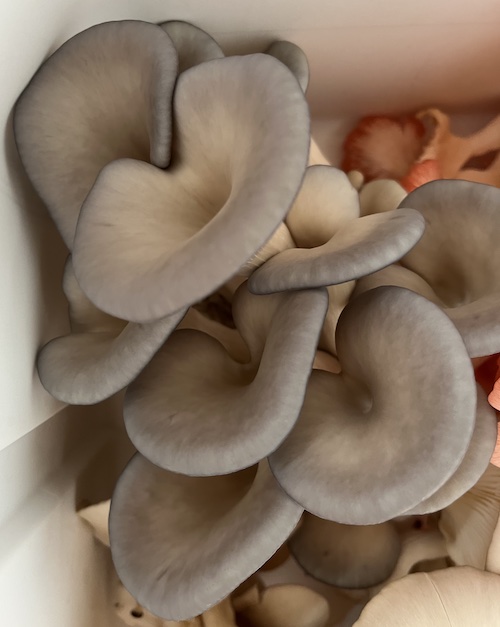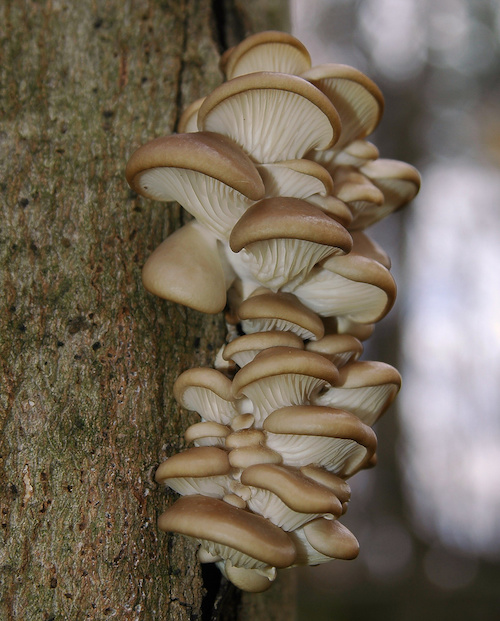Blue Oyster
Pleurotus ostreatus
Introduction:
The Blue Oyster Mushroom, scientifically known as Pleurotus ostreatus var. columbinus, is a captivating and edible fungus belonging to the Pleurotus genus. Renowned for its striking blue hue and distinct appearance, this mushroom is not only a culinary delight but also holds ecological significance. Let's explore the Blue Oyster Mushroom, delving into its biology, ecology, and cultivation.

Biology:
Taxonomy:
The Blue Oyster Mushroom is a variety of Pleurotus ostreatus, a widely distributed and economically important species in the Pleurotaceae family. Its scientific name, P. ostreatus var. columbinus, reflects its unique characteristics that distinguish it from other varieties within the same species.
Morphology:
The cap of the Blue Oyster Mushroom is characterized by a distinctive blue to bluish-gray coloration, with a texture resembling that of oysters. The cap measures between 5 to 15 centimeters in diameter and exhibits a fan or oyster-shaped structure. The gills underneath are white when young, turning lilac-gray as the mushroom matures. The stem is eccentrically attached to the cap, and both cap and stem share a mild, anise-like aroma.
Ecology:

Habitat:
Blue Oyster Mushrooms are saprotrophic, meaning they primarily feed on decaying organic matter. They are commonly found in the wild on hardwoods, particularly on dead or dying trees, logs, and branches. They play a crucial role in the decomposition of lignin and cellulose, contributing to nutrient cycling in forest ecosystems.
Distribution:
This species has a wide geographical distribution, thriving in temperate and subtropical regions across North America, Europe, and Asia. It has also become a popular subject for cultivation due to its adaptability to various environmental conditions.
Cultivation:
Substrate:
Blue Oyster Mushrooms can be cultivated on a variety of substrates, including straw, wood chips, and agricultural by-products. They have a versatile nature and are often grown on supplemented substrates for enhanced yield.
Cultivation Process:
- Substrate Preparation: Sterilize the substrate to eliminate competing organisms.
- Inoculation: Introduce the mushroom spawn to the prepared substrate.
- Incubation: Allow the mycelium to colonize the substrate in a controlled environment.
- Fruiting Conditions: Create a conducive environment with proper humidity, temperature, and fresh air exchange for the mushrooms to fruit.
- Harvesting: Harvest the Blue Oyster Mushrooms when the caps are fully developed but before the gills start to turn dark.
Culinary Uses:
Known for their mild and anise-like flavor, Blue Oyster Mushrooms are a popular choice in culinary circles. They can be sautéed, grilled, stir-fried, or used in soups and stews. The vibrant blue color adds an aesthetic appeal to a variety of dishes.
Health Benefits:
Beyond their culinary uses, Blue Oyster Mushrooms are valued for their potential health benefits. They are a good source of protein, fiber, and essential nutrients. Some studies suggest that they may possess antioxidant and immunomodulatory properties.
Conclusion:
The Blue Oyster Mushroom, Pleurotus ostreatus var. columbinus, stands out not only for its enchanting appearance but also for its ecological importance and culinary versatility. Whether thriving in the wild or cultivated for human consumption, this mushroom continues to captivate enthusiasts and researchers alike, contributing to our understanding of fungi in nature and agriculture. As research and cultivation techniques progress, the Blue Oyster Mushroom remains a fascinating subject for exploration and appreciation.